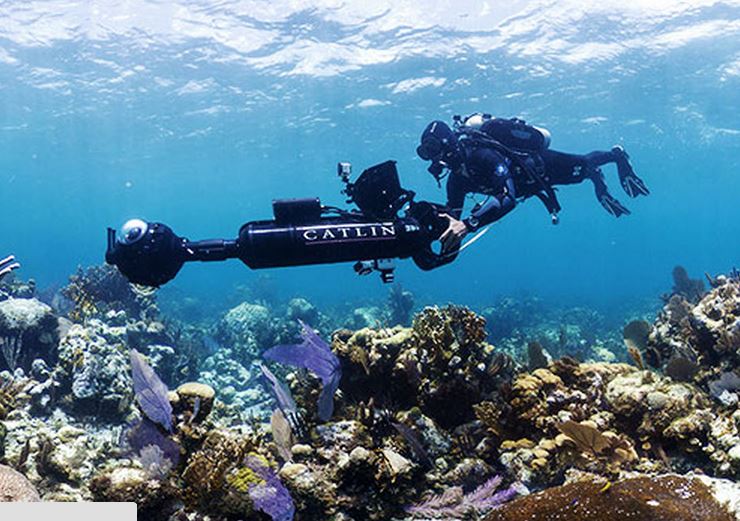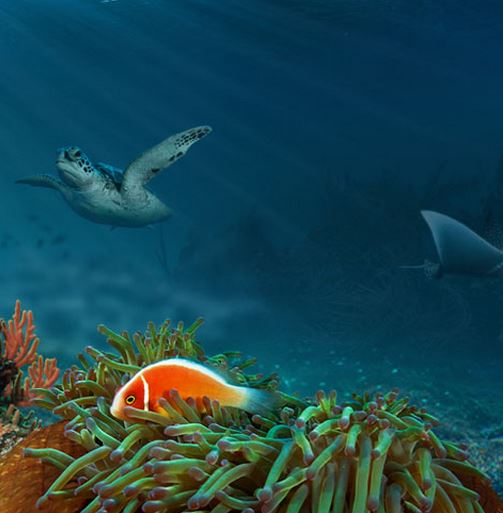The Natural History Museum in London is launching a Barrier Reef virtual dive later this month, where you can explore the world’s largest coral reef system off the coast of Australia (Great Barrier Reef), plus some others, without having to get wet or travel to the other side of the world.
Called “Coral Reefs: Secret Cities of the Sea,” the gallery space will be transformed with a bank of screens providing a 360 degree virtual immersive experience – like a “Google Street View”, but in this case of the sea floor.
It will open on March 27th, and will also include over 200 exhibits from the Museum’s collection, including the Turbinaria coral, the poisonous blue-ringed octopus and coral collected by Charles Darwin.

You can visit the most spectacular parts of the ocean bed without getting wet or having to travel across the world. (Image: Natural History Museum)
The light and sound effects recreate the sensation of being underwater.
Thanks to new technology, users will be able to zoom in and explore a variety of reefs from all over the world.
Many of the images came from the Catlin Seaview Survey, a worldwide scientific study of the world’s coral reefs, which in the museum include the Hourglass Reef in Bermuda, the Tubbataha Reef in the Philippines, and Heron Island on the Great Barrier Reef.
The Catlin Seaview divers used state-of-the art cameras that take a picture every three-to-six seconds. The images are then placed next to each other to create a panoramic view.
Dr Ken Johnson, Museum coral reefs expert, explains the importance of corals:
“Coral reefs are not simply beautiful environments. They provide food, income and storm protection for many millions of people around the world.”

The Catlin Seaview Survey is an ambitious scientific project that since 2012 has documented the health of coral reefs worldwide. (Image: Natural History Museum)
Catlin Insurance, which is helping sponsor the whole project, wrote:
“The research Catlin sponsors focuses on the oceans, which play a crucial role in the planet’s ecosystem. The Catlin Seaview Survey is an ambitious scientific project that since 2012 has documented the health of coral reefs worldwide.”
“Previously, Catlin sponsored the Catlin Arctic Survey, a three-year project that investigated changes in the fragile Arctic environment, including sea-ice melt.”
About Coral Reefs
Coral Reefs are often referred to as the “rainforests of the sea.” They form some of the most diverse ecosystems on the planet.
While occupying less than 0.1% of the oceans’ surface, or half the area of France, they provide a home for one-quarter of all marine species, including worms, mollusks, fish, sponges, crustaceans, echinoderms, tunicates and other cnidarians.

Coral Reefs are home to one-quarter of all marine life. (Image: Natural History Museum)
Most coral reefs are found at shallow depths in tropical waters, but also exist in deep and cold water.
They are very sensitive to changes in water temperature and are currently under threat from blast fishing, oceanic acidification, climate change, overuse of reef resources, and a variety of human activities.
US media are reporting that the expansion of the port of Miami is causing lasting damage to nearby coral reefs. The Army Corps of Engineers, which is in charge of overseeing the dredging, promised there would be no harm to coral life in the area.
The New York Times quoted Rachel Siverstein, executive director of Biscayne Bay Waterkeeper, the lead environmental group that is suing the Army Corps of Engineers, who said:
“We’ve seen profound and severe impacts to our reef just off of Miami; it looks like a moonscape. This damage stems from the fact that the corps and the contractors simply weren’t following the rules that were laid out for them when they started this project.”
BBC Video – Coral Reef Wonderland
